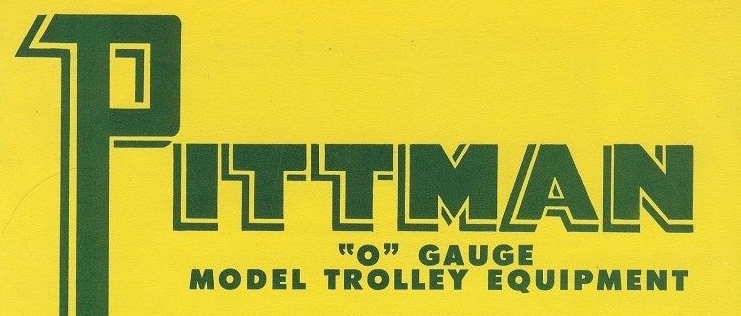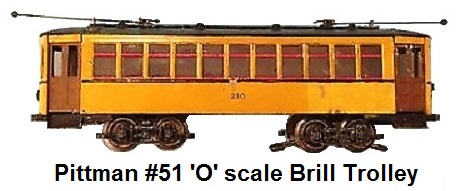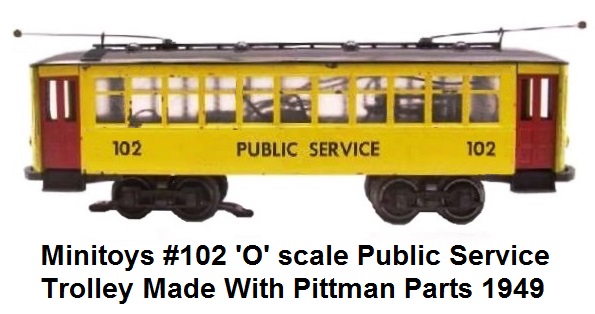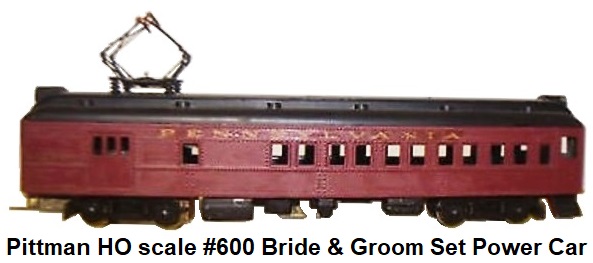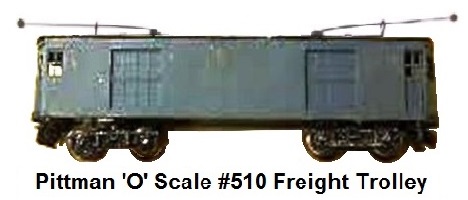|
|
The Train Collectors Association Western Division |
 |
[Home] [Train Collecting Tips page] [Index of Manufacturers]
Pittman Electric Development Co. of Sellersville, PAHistory Charles A. 'Al' Pittman, Jr. established his business in 1935. The company was first organized to produce model trolley car trucks however it was soon expanded to include HO gauge motors. Activities were conducted from Pittman's home in the Germantown section of Philadelphia, PA until early 1941 at which time the Sellersville, PA plant was purchased. Al Pittman's interests were primarily in the development of new products for the model railroad industry, specifically the trolley equipment, as it was a personal desire of long standing. In the 1940's Pittman began to issue both freight and passenger trolley kits in 'O' gauge. Over the years Pittman offered scale and tinplate 'O' gauge trolleys such as a Brill passenger streetcar, a Lehigh Valley Transit Freight Motor car, and a 4-wheel Work Car. HO offerings included a 2-car MU 'Bride & Groom' set. The company became well known for its development and production of open frame motors utilized by a multitude of other train manufacturers, eventually becoming the world's largest manufacturer of electric motors for scale model trains. The company also produced power trucks, a trolley pole kit, and the Erect-A-Wire overhead catenary system. Pittman motors would see the most use in model trains first and in the 1960's in slot cars, where their high quality and powerful product dominated the market for a number of years. Charles A. Pittman, Jr. served as President of the Pittman Electrical Development Co. and was the creator of the small DC permag motors (DC60, DC72) for HO and other small gauges as well as the permag adapter for the American Flyer HO gauge Hudson loco.
Use of 12V motors was common even before World War II (an August 1934 Moldel Railroader magazine article discussed their use) but this was likely for 'O' scale and not smaller scales. Six volt motors were the HO standard up until the war, when production of motors for hobby use ceased due to restrictions on use of materials like copper. By the end of the war opinions had changed, and 12 volts became the standard for HO. This is beleived to be the result of standardization efforts by the NMRA. There were NMRA standards for motor voltage by 1947 (12 volts for 'O', S, 'OO' and HO), but that’s after these motors were commonplace. During World War II Pittman provided their small DC motors to the US Navy for use in their ships and submarines. After World War II motor production for trains resumed in the fall of 1945, with Mantua, Pittman and Varney announcing 12-volt HO motors (Mantua’s was actually made by Pittman now) and some stores were offering a trade-in credit for people returning a 6-volt motor when buying a 12-volt model. Twelve volts would continue to be the standard track voltage for many years, and was common for HO and even 'O' gauge up to the 1970’s. Even today motors in HO are typically tested by reviewers using 12 volt power supplies, and it’s considered the standard voltage, even though the typical HO power pack is putting out 16 or more volts and the NMRA doesn’t specify standard DC voltages any more.
Al Pittman was a friend of Jim Thomas, founder of scale model manufacturer and maker of 'O' and HO trains Thomas Industries. Thomas Industries 'O' scale Baltimore & Ohio C16 class 0-4-0 steam loco employed a Pittman worm driven motor as its power plant. When Thomas released its second 'O' scale loco, a 2-8-0 Consolidation, it too utilized a Pittman electric motor. Again in the 1950's when Thomas developed its 'O' gauge 1860's era General type steam loco, Pittman worm drive motors were installed. Other scale model train manufacturers, including All Nation, Athearn, Classic Model Corp./Classic Model Trains, General Models Corp., Kusan-Auburn, Penn Line, Revell, Roberts Lines, Atlas and Weaver installed Pittman electric motors in their model locomotives over the years. Even Pittman competitors Mantua and Varney at some point in their history utilized Pittman electric motors in their trains. Pittman motors became widely utilized in other mechanisms besides trains. Some even found their way into the sirens and revolving red and blue lights on police cars. In the post-war years Pittman marketed their 'O' gauge line of semi-scale/tinplate trolley kits. These trolleys consisted of metal castings and brass parts and could operate on overhead or third rail power. The Pittman motto was, "Large Scale Realism in Small Space". The first trolley body kit was the #500 Brill trolley with smooth sides. The power truck was sold as a separate kit. All parts came unpainted. The second kit, was the Pittman #501 trolley issued in 1951. It featured scribed sides and truss rods with improved wiring that included solderless lugs for connections to the poles on the roof. The kit had everything from the trolley poles down to the floor, but no floor. The trolley side plates with windows on this kit included bottom flanges and the motor and front truck had swiveling ears that were to be screwed on top of the flanges. It was offered as separate kits for the body only ($4.75), the motor truck only ($6.95), the trail truck only ($1.25), and a third rail shoe ($1.00). The #501 complete kits sold for $13.95 and included cast passengers. In 1949 Minitoys, Inc. had acquired a sizable stock of parts from Pittman and produced ready-to-run trolleys. They sold these products via mail order and through their Hobbyland store located in Manhattan. These were the #102 public Service trolley and the #103 Rapid Transit trolley. These were painted and assembled operating versions of the 1/4" scale Brill prototype kits made by Pittman. The eleven window trolleys featured yellow sides and ends, red doors, a black or brown plastic roof with a pair of fixed, non-operating trolley poles, a black sheet metal underframe with the Minitoys logo stamped in white, black bumpers and steps, and either tinplate or flanged wheels. They sold for $19.95. A Pittman #510 freight trolley was produced in 1952 modeled after the "C" series of the Lehigh Valley Transit Company, which ran through Sellersville just behind the Pittman factory. The #510 featured diecast sides, ends, roofwalk, cow catchers, and truck sideframes with wood roof and a pair of operating poles. Trucks for the freight trolley were available from Pittman three different ways: two motor trucks, one motor truck and one trail truck, or eight-wheel drive with center motor connected to gear towers on both trucks. The #511 was sold in separate kits for the body only ($8.95), the single motor truck only ($9.00), the trail truck only ($2.50) or with the twin motor configuration set of power trucks ($17.95). The Pittman #520 four wheel work car was modeled after a J. G. Brill Co. way car that ran in Bristol, PA. between 1916 and 1934. The prototype was fitted over a 21E truck of a scrapped passenger car of the NJ & PA #217 and used for overhead line work in and around Philadelphia. The original car body may have been a horse-drawn car or an open Summer car. This Pittman car was sold as separate body and motor truck kits. Sides and ends were die-cast and the roof was wood. A center trolley pole could reverse the car depending on which direction it was positioned. The reversing single trolley pole functioned through a rotating S.P.D.T. contact built into the pole base to a wound field motor having two field windings on the same core, but wound in opposite directions to give forward or reverse magnetic field polarity. The #520 Work Car was sold in separate kits for the body ($6.95), the motor truck ($7.95) and the third rail shoe ($.90). The motor truck came with either tinplate or scale flanges on the wheels, as is true also of the Pittman #500, #501 and #511. Many of the parts sold in the Pittman kits and used in the Mintoys' trolleys were actually fabricated by Al Pittman's good friend Jim Thomas of Thomas Industries. Pittman's diecast truck sideframes, couplers, car sides for the freight and work trolleys, car ends for the work and passenger trolleys, and vestibule floor and steps were all produced by Thomas. The Pittman #600 Bride & Groom set was an HO gauge 2-car MP-54 multiple unit electric train kit. It utilized HObbyline unpainted gray plastic combine and coach body shells and included added detail parts to modify them into a motor car and trailer car. The cars utilized stamped metal frames with cast detail already riveted on. The powered motor car made use of a four wheel power truck and a dummy truck to pick-up electrical current from the track. The trailer came with two plastic dummy trucks. Both cars featured plastic HObbyline truck side frames. A single operating pantograph and special plastic MU couplers were included. The kit was priced at $14.95. The original 'O' gauge overhead wire system made by Pittman was called the Erect-A-Wire System. This overhead trolley wire system incorporated a heavy gauge phosphorous bronze wire and was solderless. It was comprised of 3/16" metal poles that were threaded at the base, and came with copper clips for attaching the overhead wire to the poles. Poles came configured with either single or double arms. The overhead "Erect-A-Wire" system was put into production sometime after the first streetcars and in conjunction with the rooftop working trolley poles. Parts could be purchased separately prior to 1954, and wire components remained available from the factory as late as 1967. "Erect-A-Wire" was developed primarily for tinplate users who wanted overhead power capabilities on their operating layouts. Pittman streetcars were not manufactured during all 12 months of the year but were made in batches at different times, as was the case with all other Pittman products, including motors. American Pittman motors were distributed in the UK through the Pritchard Patent Product Co. Ltd., as sole sales concessionaires for the British Isles. These motors were used by model railway loco makers and enthusiasts working in a variety of scales, and Pittman offered others especially for use in scale cars and boats. These Pittman motors were well received, and mentions of their use in locos by Exley, by Foster for Exley, and by Beeson for Exley, can be found in the model railway press in 1951 and 1955. Pittman motors are often found in locos that started out with different motors when first made. These changes had been thought worthwhile in order to get more power and perhaps reliability in contrast with an older motor. There usually seems to be a worm gear arrangement with Pittman motors put into UK model locos. The style and design of these motors diverged sharply from the traditional horseshoe magnet motors of the pre-war years.
The original DC-65's were vintage 1959 or so. They had a 14 lamination field, and cast brass end frames. Cast brass was really old school. The five pole armature and fine wire windings made them an excellent model train motor, but far from optimal for slot cars. On the DC-65A the brass end frames were gone, replaced by white metal castings. The motor featured about 20% more RPM, even though it had the same electrical ratings (0.7 amp maximum intermittent at 12 volts). As important and desirable as the higher RPM might have been, nothing is free in motor design, so the higher RPM came at the cost of lower torque. By mid 1963 Pittman offered both of these upgraded models in 6 volt versions which they called the DC-65A-6 and DC-85A-6. The DC-65A-6 featured an electrical upgrade to 6 volt armature windings and a design improvement of 17 thinner field laminations replacing the 14 thicker ones on the DC-65A. The thinner laminations improved the efficiency of the magnetic circuit, and the 6 volt windings produced more amp-turns in the armature, resulting in greater torque and somewhat higher RPM ratings. Late in 1963 Pittman introduced two "new" models called the DC-65X and DC-85X. Unfortunately, all the historical evidence indicates that except for slight differences in the configuration of their laminated magnet fields, the DC-65A-6 and the DC-65X motors were different in name only. The DC-85A-6 and DC-85X had no detectable differences at all. None of this seemed to matter as by early 1964, slot car motors made by the now re-named Pittman Corporation were so much in demand that for a time Pittman couldn't manufacture them fast enough.
In what seemed like a last ditch effort to remain competitive, Pittman then produced, in late 1966, a high performance version of the 6001 armature, whose part number was the same as the stock armature except it was appended with the letter "X". This time it was an X-Armature, rather than an X-Motor. Ultimately, Pittman would not compromise its dedication to quality and durability, and the rabid racers could not (at the risk of losing races) compromise their priorities for speed and power. In the end, these were divergent paths. After the 6001, Pittman's active participation in slot racing was all but over. Around 1967, Al's son Charles A. Pittman III, became involved in the company business handling correspondence for the factory. The Pittman Electrical Development Co. sales division was located at 123 W. Main St. in Kutztown, PA. The factory and service department continued to be located in Sellersville, near the Lehigh Valley Transit line. By the 1970's Pittman's business was slowly diminishing. Charles W. Pittman, Jr. had created the model railroad series of motors strictly as a "work of love" because he was also a model railroader. He got out of the business because it was no longer profitable for his company. The model trolley tooling and rights for the DC-71 motor were eventually sold to Bowser. In 1983, Lou English, the owner of Bowser, reissued the Erect-A-Wire poles for 'O' scale overhead power use. Traction Terminal purchased the remaining Pittman factory inventory. Penn Engineering acquired the Pittman Company of Sellersville, PA. In 1976 the new owner moved to a 30,000 sq. ft. manufacturing facility in Harleysville, PA. And in 1982 they introduced their first line of Pittman brushless motors. Sometime later the company was acquired by Ametek. Newer Pittman motors are still being utilized in trains. Many of the high-end 'O' gauge trains made today come equipped with Pittman can-type motors. These newer motors have ball bearings, a 7 or 9 pole armature, replaceable brushes, and some even have NIB core magnets. They typically run about 10-20 times the cost of a Mabuchi motor ($20-30 compared to $1-3), but hobbyists consider them to be well worth the extra cost. These motors have found their way into many of the modern high-end scale steam engines produced by Lionel, MTH, Right Of Way Industries, 3rd Rail(Sunset), and others.
|
